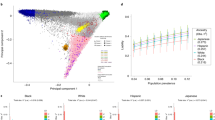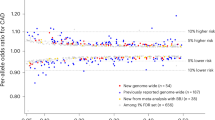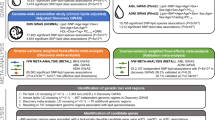Abstract
Coronary artery disease (CAD) is the commonest cause of death. Here, we report an association analysis in 63,746 CAD cases and 130,681 controls identifying 15 loci reaching genome-wide significance, taking the number of susceptibility loci for CAD to 46, and a further 104 independent variants (r2 < 0.2) strongly associated with CAD at a 5% false discovery rate (FDR). Together, these variants explain approximately 10.6% of CAD heritability. Of the 46 genome-wide significant lead SNPs, 12 show a significant association with a lipid trait, and 5 show a significant association with blood pressure, but none is significantly associated with diabetes. Network analysis with 233 candidate genes (loci at 10% FDR) generated 5 interaction networks comprising 85% of these putative genes involved in CAD. The four most significant pathways mapping to these networks are linked to lipid metabolism and inflammation, underscoring the causal role of these activities in the genetic etiology of CAD. Our study provides insights into the genetic basis of CAD and identifies key biological pathways.
This is a preview of subscription content, access via your institution
Access options
Subscribe to this journal
Receive 12 print issues and online access
$209.00 per year
only $17.42 per issue
Buy this article
- Purchase on Springer Link
- Instant access to full article PDF
Prices may be subject to local taxes which are calculated during checkout

Similar content being viewed by others
References
Berry, J.D. et al. Lifetime risks of cardiovascular disease. N. Engl. J. Med. 366, 321–329 (2012).
Peden, J.F. & Farrall, M. Thirty-five common variants for coronary artery disease: the fruits of much collaborative labour. Hum. Mol. Genet. 20 R2, R198–R205 (2011).
Kingsmore, S.F., Lindquist, I.E., Mudge, J., Gessler, D.D. & Beavis, W.D. Genome-wide association studies: progress and potential for drug discovery and development. Nat. Rev. Drug Discov. 7, 221–230 (2008).
Stein, E.A. et al. Effect of a monoclonal antibody to PCSK9 on LDL cholesterol. N. Engl. J. Med. 366, 1108–1118 (2012).
Schunkert, H. et al. Large-scale association analysis identifies 13 new susceptibility loci for coronary artery disease. Nat. Genet. 43, 333–338 (2011).
Coronary Artery Disease (C4D) Genetics Consortium. A genome-wide association study in Europeans and South Asians identifies five new loci for coronary artery disease. Nat. Genet. 43, 339–344 (2011).
Clarke, R. et al. Genetic variants associated with Lp(a) lipoprotein level and coronary disease. N. Engl. J. Med. 361, 2518–2528 (2009).
Samani, N.J. et al. Genomewide association analysis of coronary artery disease. N. Engl. J. Med. 357, 443–453 (2007).
Erdmann, J. et al. New susceptibility locus for coronary artery disease on chromosome 3q22.3. Nat. Genet. 41, 280–282 (2009).
Kathiresan, S. et al. Genome-wide association of early-onset myocardial infarction with single nucleotide polymorphisms and copy number variants. Nat. Genet. 41, 334–341 (2009).
Soranzo, N. et al. A genome-wide meta-analysis identifies 22 loci associated with eight hematological parameters in the HaemGen consortium. Nat. Genet. 41, 1182–1190 (2009).
Wang, F. et al. Genome-wide association identifies a susceptibility locus for coronary artery disease in the Chinese Han population. Nat. Genet. 43, 345–349 (2011).
The IBC 50K CAD Consortium. Large-scale gene-centric analysis identifies novel variants for coronary artery disease. PLoS Genet. 7, e1002260 (2011).
Yang, J. et al. Genome partitioning of genetic variation for complex traits using common SNPs. Nat. Genet. 43, 519–525 (2011).
Voight, B.F. et al. The Metabochip, a custom genotyping array for genetic studies of metabolic, cardiovascular, and anthropometric traits. PLoS Genet. 8, e1002793 (2012).
Teslovich, T.M. et al. Biological, clinical and population relevance of 95 loci for blood lipids. Nature 466, 707–713 (2010).
International Consortium for Blood Pressure Genome-Wide Association Studies. Genetic variants in novel pathways influence blood pressure and cardiovascular disease risk. Nature 478, 103–109 (2011).
Voight, B.F. et al. Twelve type 2 diabetes susceptibility loci identified through large scale association analysis. Nat. Genet. 42, 579–589 (2010).
Dupuis, J. et al. New genetic loci implicated in fasting glucose homeostasis and their impact on type 2 diabetes risk. Nat. Genet. 42, 105–116 (2010).
Speliotes, E.K. et al. Association analyses of 249,796 individuals reveal 18 new loci associated with body mass index. Nat. Genet. 42, 937–948 (2010).
Yang, J. et al. Conditional and joint multiple-SNP analysis of GWAS summary statistics identifies additional variants influencing complex traits. Nat. Genet. 44, 369–375 (2012).
Ken-Dror, G., Talmud, P.J., Humphries, S.E. & Dreno, F. APOE/C1/C4/C2 gene cluster genotypes, haplotypes and lipid levels in prospective coronary heart disease risk among UK healthy men. Mol. Med. 16, 389–399 (2010).
Reilly, M.P. et al. Identification of ADAMTS7 as a novel locus for coronary atherosclerosis and association of ABO with myocardial infarction in the presence of coronary atherosclerosis: two genome-wide association studies. Lancet 377, 383–392 (2011).
Heid, I.M. et al. Meta-analysis identifies 13 new loci associated with waist-hip ratio and reveals sexual dimorphism in the genetic basis of fat distribution. Nat. Genet. 42, 949–960 (2010).
Storey, J.D. & Tibshirani, R. Statistical methods for identifying differentially expressed genes in DNA microarrays. Methods Mol. Biol. 224, 149–157 (2003).
Hansson, G.K., Libby, P., Schönbeck, U. & Yan, Z.-Q. Innate and adaptive immunity in the pathogenesis of atherosclerosis. Circ. Res. 91, 281–291 (2002).
Emerging Risk Factors Collaboration. Diabetes mellitus, fasting glucose, and risk of cause-specific death. N. Engl. J. Med. 364, 829–841 (2011).
Mozaffarian, D. et al. Incidence of new-onset diabetes and impaired fasting glucose in patients with recent myocardial infarction and the effect of clinical and lifestyle risk factors. Lancet 370, 667–675 (2007).
Turnbull, F.M. et al. Intensive glucose control and macrovascular outcomes in type 2 diabetes. Diabetologia 52, 2288–2298 (2009).
Ross, R. Atherosclerosis is an inflammatory disease. Am. Heart J. 138, S419–S420 (1999).
Folkersen, L. et al. Association of genetic risk variants with expression of proximal genes identifies novel susceptibility genes for cardiovascular disease. Circ. Cardiovasc. Genet. 3, 365–373 (2010).
Grundberg, E. et al. Mapping cis- and trans-regulatory effects across multiple tissues in twins: the MuTHER Study. Nat. Genet. 44, 1084–1089 (2012).
Schadt, E.E. et al. Mapping the genetic architecture of gene expression in human liver. PLoS Biol. 6, e107 (2008).
Ge, B. et al. Global patterns of cis variation in human cells revealed by high-density allelic expression analysis. Nat. Genet. 41, 1216–1222 (2009).
Acknowledgements
We thank the personnel of the Wellcome Trust Sanger Institute (WTSI) Genotyping Facility, in particular S. Edkins, for supervising the genotyping of the AMC-PAS, Cardiogenics, GLACIER, MORGAM, PROMIS, THISEAS, and WTCCC cohorts.
AMC-PAS/SANQUIN.
We thank A.A. Soussan for technical assistance.
We thank personnel from the Estonian Genome Center of the University of Tartu (EGCUT) and the Estonian Biocentre, especially M. Hass and V. Soo, for data generation.
FINCAVAS.
We thank the staff of the Department of Clinical Physiology for collecting the exercise test data.
The GLACIER Study.
The GLACIER study is a nested study within the Northern Sweden Health and Disease Study; phenotyping was conducted as part of the Västerbotten Intervention Project. We thank the participants and the investigators from these studies for their valuable contributions, with specific thanks to L. Weinehall, Å. Agren, K. Enquist and T. Johansson.
GoDARTS Dundee.
We are grateful to all the participants who took part in this study, to the general practitioners, to the Scottish School of Primary Care for their help in recruiting the participants and to the whole team, which includes interviewers, computer and laboratory technicians, clerical workers, research scientists, volunteers, managers, receptionists and nurses. We acknowledge the support of the Health Informatics Centre at the University of Dundee in managing and supplying the anonymized data and National Health Service (NHS) Tayside, the original data owner.
Heart Protection Study.
The study was designed and conducted by the Clinical Trial Service Unit & Epidemiological Studies Unit (CTSU) at the University of Oxford. Genotyping was supported by a grant to Oxford University and Centre National de Genotypage (CNG) from Merck. The funders had no role in the design of the study or in the data collection or analysis. We especially acknowledge the participants in the study, the Steering Committee and our collaborators. J.C.H. acknowledges support from the British Heart Foundation (BHF) Centre of Research Excellence.
LOLIPOP.
We thank the participants and research staff who made the study possible.
MORGAM study.
We thank the contributing sites and key personnel, as detailed below.
Finland: We thank FINRISK, National Institute for Health and Welfare, Helsinki: V.S. (principal investigator), A. Juolevi, E. Vartiainen and P. Jousilahti; Alpha-Tocopherol, Beta-Carotene Cancer Prevention (ATBC) study, National Institute for Health and Welfare, Helsinki: J. Virtamo (principal investigator) and H. Kilpeläinen; the MORGAM Data Centre, National Institute for Health and Welfare, Helsinki: K. Kuulasmaa (responsible person), Z. Cepaitis, A. Haukijärvi, B. Joseph, J. Karvanen, S. Kulathinal, M. Niemelä and O. Saarela; and the MORGAM Central Laboratory, National Institute for Health and Welfare, Helsinki: M.P. (responsible person), P. Laiho and M. Sauramo.
France: We thank the National Coordinating Centre, National Institute of Health and Medical Research (U258), Paris: P. Ducimetière (national coordinator) and A. Bingham; Prospective Epidemiological Study of Myocardial Infarction (PRIME)/Strasbourg, Department of Epidemiology and Public Health, EA 3430, University of Strasbourg, Faculty of Medicine, Strasbourg: D. Arveiler (principal investigator), B. Haas and A. Wagner; PRIME/Toulouse, Department of Epidemiology, Toulouse University School of Medicine, Toulouse: J.F. (principal investigator), J.-B. Ruidavets, V. Bongard, D. Deckers, C. Saulet and S. Barrere; PRIME/Lille, Department of Epidemiology and Public Health, INSERM U744–Université Lille Nord de France–Institut Pasteur de Lille, Lille: P. Amouyel (principal investigator), M. Montaye, B. Lemaire, S. Beauchant, D. Cottel, C. Graux, N. Marecaux, C. Steclebout and S. Szeremeta; and the MORGAM Laboratory, INSERM U937, Paris: F.C. (responsible person), L. Tiret and V. Nicaud.
Italy: We thank Centro Ricerche EPIMED–Epidemiologia e Medicina Preventiva, Dipartimento di Medicina Clinica e Sperimentale; Università dell' Insubria, Varese: M.M.F. (principal investigator) and G. Veronesi; and Research Centre on Public Health, University of Milano–Bicocca, Monza: G. Cesana.
UK: We thank PRIME/Belfast, Queen's University Belfast, Belfast: F.K. (principal investigator), A.E. (former principal investigator), J. Yarnell and E. Gardner; and the MORGAM Coordinating Centre, Queen's University Belfast, Belfast: A.E. (MORGAM coordinator), S. Cashman and F.K.
MORGAM management group: A.E. (chair), S.S.B., F.C., M.M.F., K. Kuulasmaa, A. Palotie, M.P., A.P., V.S., H. Tunstall-Pedoe and P.G. Wiklund. Previous members: K. Asplund, L. Peltonen, D. Shields and B. Stegmayr. The PRIME Study is organized under an agreement between INSERM and the Merck, Sharpe and Dohme-Chibret Laboratory, with the following participating laboratories: The Strasbourg MONICA Project, Laboratoire d'Epidémiologie et de Santé Publique, and the Université de Strasbourg, Strasbourg, France (D. Arveiler and B. Haas); The Toulouse MONICA Project, UMR INSERM 1027, and the Department of Epidemiology, Toulouse University School of Medicine, Université Paul Sabatier, Toulouse, France (J.F. and J.-B. Ruidavets); The Lille MONICA Project, INSERM U744, Institut Pasteur de Lille and Université Lille Nord de France, Lille, France (P. Amouyel and M. Montaye); The Department of Epidemiology and Public Health, Queen's University, Belfast, Belfast, UK (A.E., J. Yarnell and F.K.); The Department of Atherosclerosis, INSERM U545, Institut Pasteur de Lille, Faculté de Médecine and Université Lille Nord de France, Lille, France (G. Luc and J.-M. Bard); The Laboratory of Haematology, INSERM U626, and Hôpital La Timone, Marseille, France (I. Juhan-Vague and P. Morange); The Laboratory of Endocrinology, INSERM U563, Toulouse, France (B. Perret); The Vitamin Research Unit, The University of Bern, Bern, Switzerland (F. Gey); The Nutrition and Metabolism Group, Centre for Public Health, Queen's University Belfast, Belfast, UK (J. Woodside and I. Young); The DNA Bank, INSERM/Université Pierre et Marie Curie (UPMC), Paris Université Unite Mixte de Recherche (UMRS) 937, Paris (F.C.); The Coordinating Centre, Institut Fédératif de Recherche Santé Publique (IFR 69), Villejuif, France (P. Ducimetière); and INSERM U970, Villejuif, France, and University Paris V, Paris Cardiovascular Research Centre (PAARC), Paris (A. Bingham).
PIVUS/Swedish Twin Registry.
We thank the SNP&SEQ Technology Platform in Uppsala (see URLs) for genotyping, in particular T. Axelsson, A.-C. Wiman and C. Pöntinen for excellent assistance.
Ulm (EMIL).
We thank the Centre of Excellence Baden-Wuerttemberg Metabolic Disorders.
WTCCC.
We thank the BHF Family Heart Study Research Group for the collection of the cases.
Author information
Authors and Affiliations
Consortia
Contributions
Writing committee: P. Deloukas, S. Kanoni, C.W., M.F., T.L.A., J.R.T., E.I., D. Saleheen, J.E., M.P. Reilly, R. Collins, S. Kathiresan, A.H., U.T., J.S.K., J.D., C.N.A.P., R.R., H.W., H.S. and N.J.S. Steering committee: P. Deloukas, S. Kanoni, C.W., M.F., T.L.A., J.R.T., E.I., D. Saleheen, J.E., M.P. Reilly, R. Collins, S. Kathiresan, A.H., U.T., J.S.K., J.D., C.N.A.P., R.R., H.W., H.S., N.J.S., S.S.B., B.O.B., J.C.C., R. Clarke, G.D., P.W.F., C.H., G.K.H., Jong-Young Lee, T.L., W.M., A.M., M.S.N., C.O., M.P., S. Ripatti, M.S.S., S.S., A. Siegbahn, C.J.W. and P.A.Z. Analysis committee: B.A.G., K. Stirrups, I.R.K., J.-B.C., Å.J., T.E., L.F., A.G., A.S. Havulinna, W.K.H., J.C.H., N.E., M.E.K., K. Kristiansson, P.L., L.-P.L., S. Rafelt, D. Shungin, R.J.S., G. Thorleifsson, E.T., N.V.Z., B.F.V., L.L.W., W.Z. and A.Z. Genotyping: D. Absher, I.B., C.B., S.C.-B., DIAGRAM Consortium, N.E.M., K.F., P.F., B.G., L.G., S.G., J.H., B.-G.H., S.E.H., T.K., J.W.K., C. Langenberg, C. Langford, M.I.M., M.M.-N., K.N., J.F.P., S. Rosinger, D.R., M.P. Rumpf, A. Schäfer, A.F.R.S., P.J.W. and Wellcome Trust Case Control Consortium. Array design: H.M.K. and N.W.R. Functional analyses: E.G., P.E., A.F.-C., A.L., O.M., S.M., MuTHER Consortium, T.-P.Y., A.H.G., E.S., T.P. and A.-C.S. Samples and phenotyping: (ADVANCE) A.S.G., C.I. and T.Q.; (AMC-PAS/SANQUIN) C.E.v.d.S. and H.B.; (Angio-Lüb/KORA) P. Diemert; (CADomics) P.S.W.; (CARDIOGENICS) F.C. and W.H.O.; (CHARGE) E.B., A.L.C., A.D. and V.G.; (Corogene) M.-L.L. and J.S.; (deCODE) G. Thorgeirsson, H.H. and K. Stefansson; (EPIC-NORFOLK) N.W.; (Estonian Biobank) E.M.; (FGENTCARD) D.G.; (FINCAVAS) M.K.; (FINRISK 2007/DILGOM) V.S.; (FRISCII) L.W.; (GerMIFS) T.I., C.M., K. Stark and M.E.Z.; (GLACIER) G.H.; (GoDARTS Dundee) A.S.F.D. and A.D.M.; (HPS) S.P.; (Korean GenRIC) Y.J., H.-S.K., Ji-Young Lee and J.E.P.; (LOLIPOP) S.-T.T.; (LURIC/AtheroRemo) R.L. and W. Koenig; (METSIM) J.K., M.B. and M.L.; (MIGen) R.D.; (MORGAM) K. Kuulasmaa, J.V., P.A., D. Arveiler., J.F., D.-A.T., N.K., A.P., P.B., M.M.F., A.E. and F.K.; (Ottawa Heart Genomics Study) G.A.W., S.L.H. and S.H.S.; (PennCATH/MedStar) S.E.E. and D.J.R.; (Pfizer-Broad-Malmo) D. Altshuler and D.C.; (PIVUS/Swedish Twin Registry) C.S., L.L. and N.L.P.; (PROMIS) A.R.; (SHEEP-SCARF) K.L. and U.d.F.; (THISEAS) M.D., G.K.; (Ulm-EMIL) W. Kratzer; and (WTCCC) A.J.B., P.S.B., M.S. and A.S. Hall.
Corresponding authors
Ethics declarations
Competing interests
The authors declare no competing financial interests.
Additional information
A list of members and affiliations appears in the Supplementary Note.
A list of members and affiliations appears in the Supplementary Note.
A list of members and affiliations appears in the Supplementary Note.
A list of members and affiliations appears in the Supplementary Note.
Supplementary information
Supplementary Text and Figures
Supplementary Figures 1–7, Supplementary Tables 1–8 and Supplementary Note (PDF 2619 kb)
Supplementary Table 9
SNPs at an FDR⩽5% and LD threshold of r2 < 0.2 used in estimating heritability (XLS 88 kb)
Supplementary Table 10
Network molecules (XLS 114 kb)
Rights and permissions
About this article
Cite this article
The CARDIoGRAMplusC4D Consortium., Deloukas, P., Kanoni, S. et al. Large-scale association analysis identifies new risk loci for coronary artery disease. Nat Genet 45, 25–33 (2013). https://doi.org/10.1038/ng.2480
Received:
Accepted:
Published:
Issue Date:
DOI: https://doi.org/10.1038/ng.2480
This article is cited by
-
HDL levels modulate the impact of type 2 diabetes susceptibility alleles in older adults
Lipids in Health and Disease (2024)
-
Lipoprotein (a) and myocardial infarction: impact on long-term mortality
Lipids in Health and Disease (2023)
-
Association of polymorphisms of renin angiotensin system and endothelial nitric oxide synthase genes with premature cardiovascular disease in an Iranian population
BMC Cardiovascular Disorders (2023)
-
Lipoprotein(a), platelet function and cardiovascular disease
Nature Reviews Cardiology (2023)
-
Protective role of CXCR7 activation in neonatal hyperoxia-induced systemic vascular remodeling and cardiovascular dysfunction in juvenile rats
Scientific Reports (2023)



